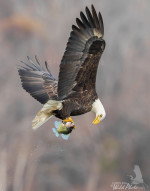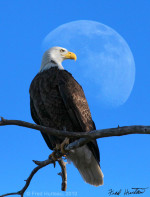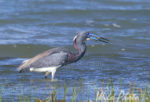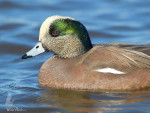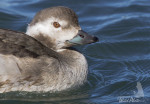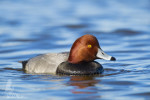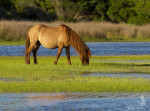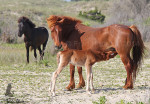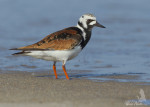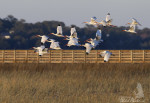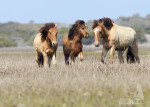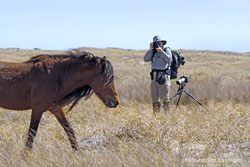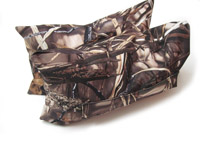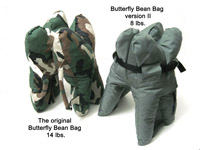Wind, Sea and Wild Horses
by admin on Apr.22, 2018, under Locations
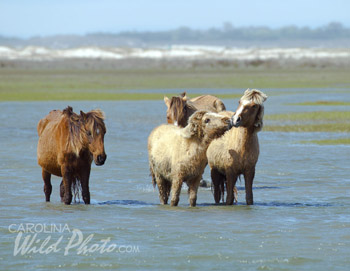 It’s late April, and finally winter has reluctantly released its grip, allowing some Spring-like weather to filter into the Carolinas. Though the temps were up a bit and the sun was out, a 20 to 30 mph wind relentlessly buffeted the coast for the entire three days of our trip to Beaufort and Shackleford Banks for some wild horse photography.
It’s late April, and finally winter has reluctantly released its grip, allowing some Spring-like weather to filter into the Carolinas. Though the temps were up a bit and the sun was out, a 20 to 30 mph wind relentlessly buffeted the coast for the entire three days of our trip to Beaufort and Shackleford Banks for some wild horse photography.
That didn’t stop the wife and I from our mission to get photos, but it did make the private charter boat rides across Back Sound as rough as what we get in the winter months around Beaufort and Shackleford Banks.
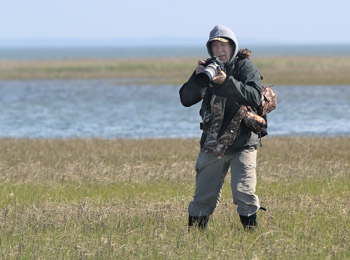 The morning of our first day our guide (and boat captain) ferried us from the Beaufort Yacht Basin out to the eastern end of Shackleford Banks, directly across from Cape Lookout Lighthouse. Along the way we stopped at two islands to photograph some horses grazing there. These “islands” are actually grassy shoals that barely peek above the water at high tide, just enough for the salt marsh grass to grow. The water is so shallow here that only the smaller flat-bottom boats can manage to reach them. For the serious photographer that’s important. It’s why I hire Captain Monty with Seavisions Charters for these excusions. He knows the horses, the waters, and the area, and can get me to the places the “tour” boats can’t get to.
The morning of our first day our guide (and boat captain) ferried us from the Beaufort Yacht Basin out to the eastern end of Shackleford Banks, directly across from Cape Lookout Lighthouse. Along the way we stopped at two islands to photograph some horses grazing there. These “islands” are actually grassy shoals that barely peek above the water at high tide, just enough for the salt marsh grass to grow. The water is so shallow here that only the smaller flat-bottom boats can manage to reach them. For the serious photographer that’s important. It’s why I hire Captain Monty with Seavisions Charters for these excusions. He knows the horses, the waters, and the area, and can get me to the places the “tour” boats can’t get to.
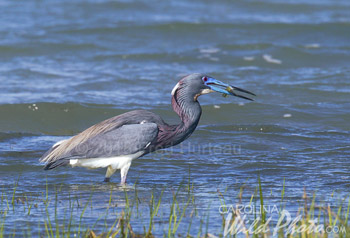 My wife took the photo of me above while I photographed the colorful Tri-colored Heron in breeding plumage (shown at right) as it caught fish along the edge of the island. You can’t tell from the photo, but I’m wading in about two inches of water in the grass at high tide. These islands are also a good spot to get photos of the horses with the Cape Lookout Lighthouse in the background. This day I got my best shot yet from this island of a horse with the lighthouse behind it, shown below.
My wife took the photo of me above while I photographed the colorful Tri-colored Heron in breeding plumage (shown at right) as it caught fish along the edge of the island. You can’t tell from the photo, but I’m wading in about two inches of water in the grass at high tide. These islands are also a good spot to get photos of the horses with the Cape Lookout Lighthouse in the background. This day I got my best shot yet from this island of a horse with the lighthouse behind it, shown below.
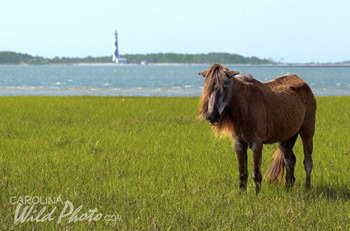 We went on to photograph more horses on the eastern end of Shackleford the rest of the morning. Then we returned to Beaufort for lunch and a break, and got ready for the afternoon excursion to Rachel Carson Reserve.
We went on to photograph more horses on the eastern end of Shackleford the rest of the morning. Then we returned to Beaufort for lunch and a break, and got ready for the afternoon excursion to Rachel Carson Reserve.
We headed out at 4pm for Town Marsh, the western end of Rachel Carson Reserve, to find the horses there. The wind was still blowing, and had not let up all day long. This day the main “herd” of about two dozen horses were far out on the ocean side of the reserve on “Horse Island”, beyond the expansive marsh.
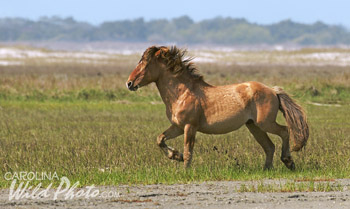 Based on past experience we expected that by the time we could walk the mile or so out to where they were feeding it would be about time they usually headed back to where we were waiting near the watering hole. With the winds still blowing so strong, it would be a rough boat ride on the ocean side to reach them. So we decided to wait for them to come to us. But when the sun began to get low and it was time for us to call it a day, the horses were still feeding on Horse Island, showing no signs of heading back for fresh water. So we had to leave them.
Based on past experience we expected that by the time we could walk the mile or so out to where they were feeding it would be about time they usually headed back to where we were waiting near the watering hole. With the winds still blowing so strong, it would be a rough boat ride on the ocean side to reach them. So we decided to wait for them to come to us. But when the sun began to get low and it was time for us to call it a day, the horses were still feeding on Horse Island, showing no signs of heading back for fresh water. So we had to leave them.
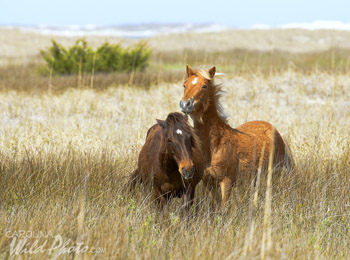 We would come back in the morning and try again. If they still preferred to feed at Horse Island in the morning, we would have plenty of time to make the trek out there, or take the boat around.
We would come back in the morning and try again. If they still preferred to feed at Horse Island in the morning, we would have plenty of time to make the trek out there, or take the boat around.
The morning of day two we headed out for Rachel Carson Reserve with Captain Monty. The wind had howled all night and was still blowing the same as the previous day. We found the horses hanging out at the watering hole on Town Marsh and discovered a wooly little yearling there. This little fellow kept us entertained most of the day as we followed the horses around taking photos. They eventually took to the cedar trees to feed on the stubby grass growing there. We watched and photographed until noon and returned to Beaufort for a midday break.
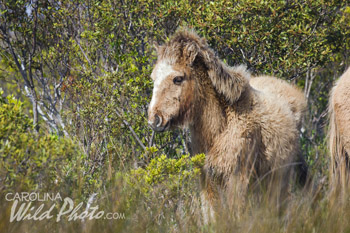 After our break we returned around 4pm as the daylight softened. The horses were nowhere to be seen out in the open, so we went looking. Captain Monty went one way, directing us to go looking another way and meet up with him at a spot we both knew of. He found some horses feeding along Taylor Creek, shielded from the wind by the maritime forest of cedars, and we found the rest wandering among the short, thick cedars feeding on the stubby grass that grows there on what little high ground there is on the island. The horses can be hard to find when among the trees, and often the only clue is listening for them whinnying to each other.
After our break we returned around 4pm as the daylight softened. The horses were nowhere to be seen out in the open, so we went looking. Captain Monty went one way, directing us to go looking another way and meet up with him at a spot we both knew of. He found some horses feeding along Taylor Creek, shielded from the wind by the maritime forest of cedars, and we found the rest wandering among the short, thick cedars feeding on the stubby grass that grows there on what little high ground there is on the island. The horses can be hard to find when among the trees, and often the only clue is listening for them whinnying to each other.
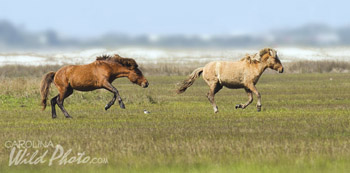 Eventually they moved out from among the trees and back to the watering hole. Finally the horses were back at their old habits, which meant that with the evening gathering at the watering hole came the usual “horsing around” action….. stallions chasing each other or fighting. There was no real fighting this day, but the stallions did put on a show, prancing around and chasing each other.
Eventually they moved out from among the trees and back to the watering hole. Finally the horses were back at their old habits, which meant that with the evening gathering at the watering hole came the usual “horsing around” action….. stallions chasing each other or fighting. There was no real fighting this day, but the stallions did put on a show, prancing around and chasing each other.
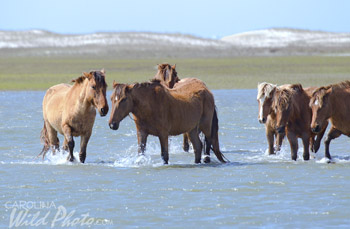 Before long the whole gathering moved out onto the marsh for awhile. Then they filed back to the watering hole, splashing through water, providing some picturesque shots. Horses splashing in water always makes for interesting images. It is the thing, along with sand dunes, that makes these wild horse images recognizable as being wild, and in a coastal setting.
Before long the whole gathering moved out onto the marsh for awhile. Then they filed back to the watering hole, splashing through water, providing some picturesque shots. Horses splashing in water always makes for interesting images. It is the thing, along with sand dunes, that makes these wild horse images recognizable as being wild, and in a coastal setting.
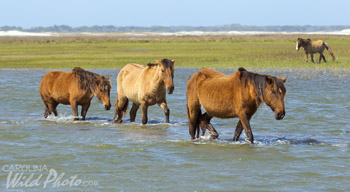 The action photos and water splashing photos of the afternoon gave me lots of images to work with. It was just what I had hoped to get. It made up for missing out on the afternoon shots from the first day when the horses were so far off with insufficient time to reach them before the daylight failed us. I was quite satisfied with the results.
The action photos and water splashing photos of the afternoon gave me lots of images to work with. It was just what I had hoped to get. It made up for missing out on the afternoon shots from the first day when the horses were so far off with insufficient time to reach them before the daylight failed us. I was quite satisfied with the results.
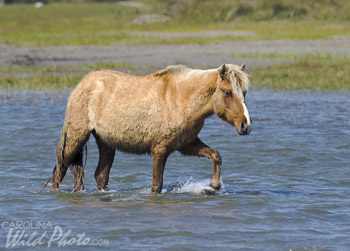 Except for the wind, the weather had been nearly perfect. And even the wind wasn’t so cold as to make it uncomfortable. It was only an issue so far as steadying the cameras while taking shots, and of course, making the boat rides on open waters a bit bouncy. We got what we came for, thanks to Captain Monty’s assistance and knowledge in finding the horses quickly.
Except for the wind, the weather had been nearly perfect. And even the wind wasn’t so cold as to make it uncomfortable. It was only an issue so far as steadying the cameras while taking shots, and of course, making the boat rides on open waters a bit bouncy. We got what we came for, thanks to Captain Monty’s assistance and knowledge in finding the horses quickly.
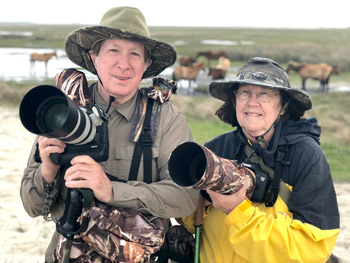
 This blog is an extension of the
This blog is an extension of the 